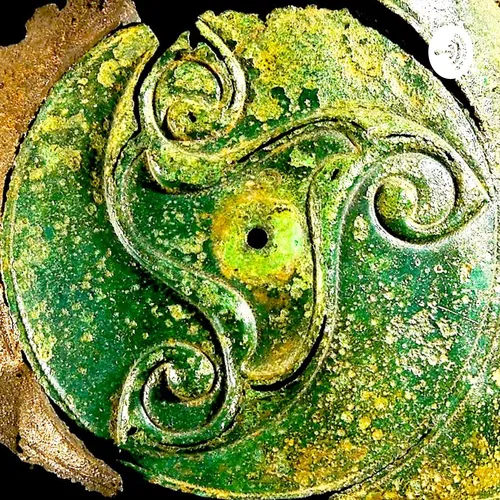
Celtic Source
Dr Gwilym Morus-Baird discusses various aspects of Celtic myth and culture, with a particular focus on Welsh and Irish source texts.
- Update frequency
- every 9 days
- Average duration
- 27 minutes
- Episodes
- 78
- Years Active
- 2020 - 2025

38. Was witchcraft a religion in medieval Wales?
Clearly, witchcraft — as part of the broader set of beliefs we call paganism — was an aspect of a nature religion in the folk culture of medieval Wales. But sometimes we need to be a bit careful with…

37. The Mabinogi Challenge: Day 1 Recording
A recording of the first day of the Mabinogi Challenge.
Over the course of 5 days we're working through a simple process by which you can begin to interpret and understand a short folk-tale from th…

36. The Dark Side of the hero Myth pt 2
In this second talk on Canu Llywarch Hen, the 9th century Welsh poems that tell the story of Llywarch the Old and his 24 sons, we talk through Llywarch's lament for his son, the fallen warrior Gwên. …

35. The Dark Side of the Hero Myth pt 1
Canu Llywarch Hen, the sequence of 9th century Welsh poems about the tragedy of Llywarch the Old and his 24 sons, is one of the most important works in Welsh literature. But far from joining in with …

34. The Song of Heledd pt 2
In this second video on Canu Heledd ('The Song of Heledd') we look at what could have led to such a tragedy. There are suggestions in the poems that Heledd considers herself to be to blame for the de…

33. The Song of Heledd pt 1
Canu Heledd ('The Song of Heledd') is a sequence of 9th century Welsh poems commemorating the loss of territory to Saxons when they invaded the kingdom of Powys. The main character in these dramatic …

32. Did a woman write the Mabinogi?
Who wrote The Four Branches of the Mabinogi? That's a question numerous Celtic scholars have attempted to answer over the years, but none have been able to provide definitive proof to support their c…

31. 'The Battle of the Trees' and The White Goddess
Robert Graves' White Goddess is one of the most popular books ever written on modern Celtic mysticism, but as well as entrancing countless modern readers it has also enraged many Celtic scholars.
Per…

30. Ritual Masks and Channeling
What can the almost universal practice of ritual mask wearing tell us about the Welsh bardic tradition? As far as we know, the medieval Welsh bards didn't use masks in performance, but they did take …

29. Why interpret myths?
In answer to a question that comes up every now and again:
Why focus on interpretation? Shouldn’t we just cover the historical facts and let people decide for themselves what something means?
Unfortu…

28. Bardic Craft and Animal Transformation
This video is in answer to two questions sent in from The Taliesin Tradition course:
- what is the bardic craft of classical Welsh poetry?
- what evidence is there for human to animal transformatio…

27. Who is the gatekeeper?
Concluding this short series on Welsh Arthurian poems we take a look at the broader use of the 'enchanted fortress' motif and see how it's used to evoke several different themes, both sociological an…

26. The Spoils of Annwfn
Continuing with this short series on Welsh Arthurian poems, this talk takes a look at Preideu Annwfyn (The Spoils of Annwfn), one of the better known poems from the medieval Book of Taliesin. Like ma…

25. The Discourse of Arthur and the Eagle.
'The Discourse of Arthur and the Eagle' is a 12th century Welsh poem that was very popular in the Welsh oral and written tradition. Even though it's a poem about Christian learning, it also draws on …

24. A Welsh Cailleach?
When we compare Welsh folktales about giant witches and their stone cairns to stories about the Cailleach of Ireland and Scotland, we find some very interesting similarities.

23. Are Welsh scholars misrepresenting historical paganism?
In recent decades, several authors on Celtic myth and spirituality have been accused of misrepresented the cultural history of Wales. But what of Welsh scholars? Are they also misrepresenting Welsh …

22. The Giant's Beard
In this last in the series on Welsh folklore, we look at the peculiar phenomena of the Giant's Beard and what it could have stood for in the ancient past.

21. Iolo Morganwg and Fake Myths
A very frequently asked question amongst modern druids is what (if anything), can be taken from the work of Iolo Morganwg, the founding father of modern druidry and notorious forger of ‘ancient’ text…

20. Barclodiad y Gawres (The Giantess' Apronful)
This neolithic tomb on Ynys Môn isn't the only cairn to be named after a giant witch . . .

19. From Celtic Gods to Celtic Spirits
What happened to the Celtic gods of Iron Age Europe? Where are they in later Celtic folklore?